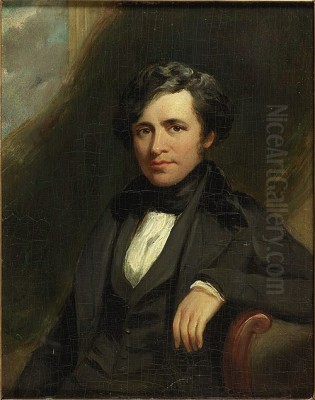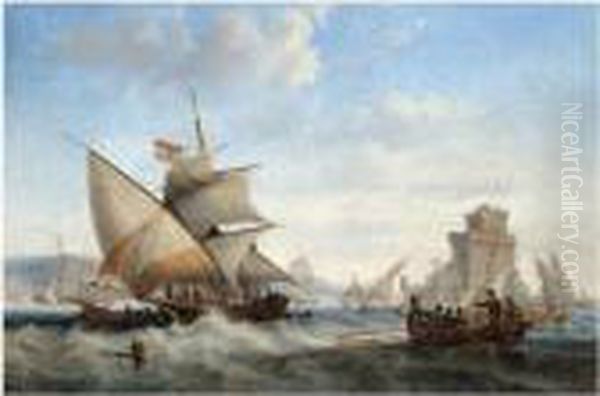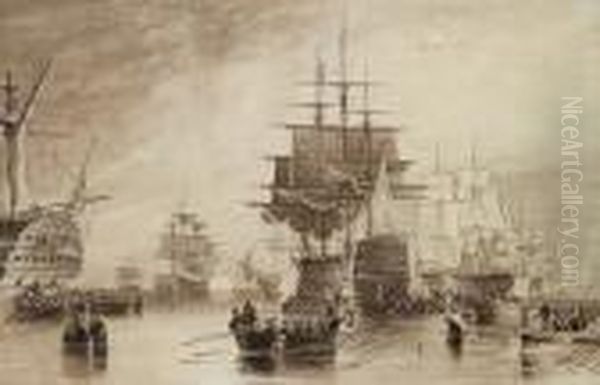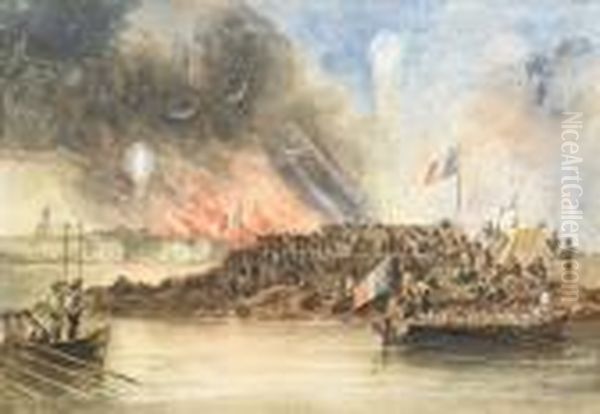
John Wilson Carmichael stands as a significant figure in the rich tradition of British marine painting. Active during the vibrant, transformative era of the 19th century, he captured the essence of the sea, the ships that sailed upon it, and the bustling life of the coasts with remarkable skill and sensitivity. Born into the heart of England's burgeoning industrial north, his life and art were intrinsically linked to the maritime world, reflecting both the romantic allure and the practical realities of seafaring during a period of immense change. His legacy is that of a meticulous observer, a talented draughtsman, and a painter who could convey both the dramatic power and the serene beauty of the ocean.
Early Life and Formative Years by the Sea
James John Wilson Carmichael, known professionally as John Wilson Carmichael, entered the world on June 9, 1800, in Newcastle-upon-Tyne, a bustling port city in the northeast of England. His father was a shipwright, a craftsman involved in the construction and repair of vessels. This familial connection to shipbuilding undoubtedly immersed the young Carmichael in the sights, sounds, and atmosphere of the maritime environment from his earliest days. The River Tyne, crowded with collier brigs, fishing boats, and larger trading ships, would have been a constant backdrop to his childhood.
This early exposure fostered a deep and abiding fascination with the sea. Rather than pursuing a purely land-based education or trade, Carmichael sought direct experience on the water. Around the age of sixteen, he embarked on a life at sea, serving aboard vessels navigating the routes between Britain, Spain, and Portugal. This period, lasting approximately three years, was not merely an adventure; it was a profound education. He learned firsthand about the complex workings of sailing ships, the unpredictable nature of wind and weather, and the diverse moods of the ocean – knowledge that would later infuse his paintings with authenticity.

Upon returning to Newcastle, Carmichael did not immediately turn to art. He followed a path closer to his father's trade, becoming an apprentice shipwright in a local shipyard. This practical training further deepened his understanding of ship construction and design. However, the call of art proved strong. During his apprenticeship, he dedicated his free time to sketching and painting, honing his observational skills and developing his artistic talents. The ships he helped build by day became the subjects of his drawings by night.
The Emergence of a Marine Artist
By the age of twenty-three, around 1823, Carmichael made the pivotal decision to dedicate his life to art. Forsaking the security of the shipbuilding trade, he embraced the less certain path of a professional painter. He initially established himself as a drawing master and miniaturist, skills that required precision and attention to detail – qualities that would become hallmarks of his later marine work. He opened a studio in his native Newcastle, a city with a growing appreciation for the arts, partly fueled by its industrial prosperity.
A significant influence during this formative period was the established Newcastle landscape painter, Thomas Miles Richardson Sr. (1784-1848). Carmichael is known to have studied with Richardson, or at the very least, worked in close association, possibly sharing studio space for a time. Richardson, a prominent figure in the Newcastle art scene and a founder of the Northumberland Institution for the Promotion of the Fine Arts, likely provided Carmichael with valuable guidance, technical instruction, and exposure to the professional art world. Richardson's own detailed approach to landscape may have reinforced Carmichael's inclination towards accuracy.
Carmichael quickly gained a local reputation for his marine subjects. His intimate knowledge of ships and the sea, combined with his developing artistic skill, allowed him to create works that resonated with the Tyneside community, whose fortunes were so closely tied to maritime commerce and industry. His paintings from this period often depict scenes along the Tyne and the nearby coast, capturing the specific character of the region's shipping and shoreline.
The Painter's Eye: Subject and Style
Carmichael's primary focus throughout his career remained the sea and everything associated with it. His canvases feature a wide array of vessels: majestic naval warships, sturdy merchantmen, elegant yachts, humble fishing cobles, and bustling steamships that were beginning to transform maritime transport. He painted ships in harbor, moored against quaysides, navigating busy rivers, battling storms on the open ocean, and participating in naval engagements. Ports like his native Newcastle, Sunderland, London, Portsmouth, and locations visited on his travels, such as those in the Netherlands or the Mediterranean, provided rich settings for his work.

His style evolved but consistently retained a strong element of realism and meticulous detail, particularly in the rendering of ships. His background as a shipwright's apprentice gave him an unparalleled understanding of naval architecture, rigging, and the way ships behaved under sail or steam. This technical accuracy earned him the respect of sailors and ship owners, who could recognize the specific types of vessels and the correctness of their depiction. He was adept at capturing the textures of wood, canvas, water, and stone.
However, Carmichael was not merely a technical illustrator. He worked firmly within the British Romantic tradition, influenced by the dramatic seascapes of earlier masters like Charles Brooking (c.1723-1759) and Nicholas Pocock (1740-1821), and contemporary giants such as J.M.W. Turner (1775-1851) and Clarkson Stanfield (1793-1867). While perhaps not reaching the sublime, almost abstract energy of Turner's late works, Carmichael skillfully employed light and atmosphere to create mood and drama. He excelled at depicting the play of sunlight on water, the gathering gloom of a storm, the haze of a busy port, or the clear light of a coastal morning.
Capturing Light, Weather, and Atmosphere
A key strength of Carmichael's art lies in his ability to render atmospheric effects and the changing conditions of weather. He understood how light interacted with water, clouds, and sails. His paintings often feature dramatic skies, whether filled with billowing white clouds against a blue expanse or heavy with the dark, turbulent masses of an approaching storm. He captured the transparency of calm water, the choppy energy of a brisk breeze, and the terrifying power of storm-tossed waves.
His 1840 painting, Sunderland Old Pier and Lighthouse with Ryhope Church in the distance, is a fine example of his ability to combine topographical accuracy with atmospheric drama. It depicts a merchant brig that has lost its mast in a gale, struggling near the pier. The turbulent sea, the wind-whipped spray, and the dramatic lighting convey the peril of the situation, while the accurately rendered pier and distant church anchor the scene in a specific location. This sensitivity to weather and light aligns him with other Romantic painters like Copley Fielding (1787-1855), who also excelled in capturing the nuances of the British climate.

Carmichael's use of light often served to highlight the focal points of his compositions – a ship's sails catching the sun, the gleam of light on wet decks, or the dramatic silhouette of a vessel against a bright horizon. This careful manipulation of chiaroscuro (light and shadow) adds depth and dynamism to his work, drawing the viewer's eye and enhancing the emotional impact of the scene. His approach, while distinct, shows an awareness of the techniques used by Turner and Stanfield to infuse their seascapes with energy and luminosity.
Recognition and Major Works
By the late 1830s, Carmichael's reputation had grown beyond Newcastle. He began exhibiting regularly at major London institutions, significantly raising his national profile. From 1838 onwards, his works were frequently seen at the prestigious Royal Academy of Arts (RA). He also exhibited at the British Institution and the Society of British Artists on Suffolk Street, venues that showcased the work of many leading artists of the day.
Several paintings stand out as representative of his skill and thematic interests. The Arrival of the Royal Squadron (1843), likely depicting a naval review or royal visit, showcases his ability to handle complex compositions involving numerous ships and ceremonial occasions, demanding both accuracy and a sense of grandeur. Such works appealed to patriotic sentiments and the public's fascination with the Royal Navy, a subject also tackled by contemporaries like William John Huggins (1781-1845), who held the title of Marine Painter to the King.
His historical paintings also garnered attention. The Shannon and the Chesapeake (exhibited RA 1841) depicted a famous naval duel from the War of 1812 between Britain and the United States. This work required careful research to ensure the accuracy of the ships and the events, demonstrating Carmichael's versatility in moving beyond contemporary observation to historical reconstruction, a genre also explored by Clarkson Stanfield.
Another significant work, The Conqueror towing the Boats off the Troughalas (possibly related to naval actions), further cemented his reputation for detailed and dramatic naval scenes. His depictions of specific, identifiable locations, such as On the Tagus (1842), reflecting his earlier travels or later visits, added an element of the exotic and demonstrated his ability to capture the unique light and atmosphere of foreign ports, akin to topographical artists like Samuel Prout (1783-1852) or David Roberts (1796-1864), though Carmichael's focus remained resolutely maritime.
London, Illustration, and the Crimean War
In 1845, seeking greater opportunities and access to the heart of the British art world, Carmichael relocated from Newcastle to London. This move placed him in closer proximity to the major exhibition venues, patrons, and fellow artists who dominated the scene. While the claim that he shared a studio with J.M.W. Turner is likely inaccurate – their paths and temperaments were quite different – he certainly moved within the same artistic milieu and would have been acutely aware of Turner's towering presence and influence, as well as the work of other leading marine and landscape painters like Stanfield and Edward William Cooke (1811-1880), both known for their meticulous detail and maritime subjects.
A notable development during his London period was his work as an illustrator. He contributed drawings to the highly popular Illustrated London News, a publication that brought visual reporting to a wide audience. His most significant contributions came during the Crimean War (1853-1856). Carmichael produced dramatic scenes of the conflict, particularly the naval actions in the Baltic Sea.
His depiction of the Bombardment of Sveaborg [Suomenlinna], 9 August 1855, is a powerful example. Based on sketches likely provided by officers present at the scene, the work captures the intensity of the naval assault on the Russian fortress near Helsinki. These illustrations served a quasi-documentary function, providing the British public with vivid images of a distant war. While praised for their accuracy and detail, this illustrative work sometimes drew criticism for potentially lacking the deeper emotional resonance found in purely 'fine art' paintings. Nonetheless, it showcased his ability to adapt his skills to the demands of visual journalism and brought his work to an even broader public. Other artists, like William Simpson (1823-1899), also gained fame as war artists during this period, highlighting the growing importance of visual reporting.
Contemporaries and the Maritime Context
John Wilson Carmichael worked during a golden age for British marine painting. The nation's identity and prosperity were inextricably linked to the sea – through naval power, global trade, exploration, and fishing. This created a strong market for paintings that celebrated maritime achievements, recorded specific ships and locations, or simply captured the beauty and power of the ocean.
Carmichael was part of a vibrant community of marine specialists. He followed in the wake of earlier 18th and early 19th-century painters like Nicholas Pocock and Thomas Luny (1759-1837), who established traditions of accurate ship portraiture and naval battle scenes. His direct contemporaries included some of the most respected names in British art. Clarkson Stanfield, like Carmichael, had direct experience at sea and rose to become a leading painter of marine and landscape subjects, known for his dramatic compositions and technical polish. E.W. Cooke, younger than Carmichael, brought an almost scientific precision to his depictions of shipping and coastal scenes, reflecting his family background in engraving and illustration.
George Chambers Sr. (1803-1840), another painter with practical seafaring experience, produced lively and atmospheric marine views before his early death. The tradition of ship portraiture continued with artists specializing in depicting specific vessels for owners and captains. While Carmichael's work often included accurate ship depictions, his broader focus on atmosphere, location, and narrative distinguished him from purely ship portraitists. He also shared the artistic landscape with landscape painters who frequently included coastal or river scenes in their work, such as members of the Norwich School like Joseph Stannard (1797-1830), or later popular watercolourists like Myles Birket Foster (1825-1899), although Foster's style was generally more idyllic.
Carmichael's relationship with these contemporaries appears to have been one of mutual awareness and professional coexistence rather than intense rivalry or close collaboration. He carved out his own niche, blending Romantic sensibility with a Northerner's practicality and an insider's knowledge of the maritime world. His style, while influenced by giants like Turner, retained its own distinct character – detailed, informative, yet capable of conveying genuine atmosphere and emotion.
Later Years and Enduring Legacy
In his later years, Carmichael left the bustle of London and moved to the coastal town of Scarborough in Yorkshire. This location, a popular seaside resort and fishing port, provided him with continued access to the maritime subjects he loved. He continued to paint, capturing the Yorkshire coast and its shipping activities.
Despite a long and productive career, and considerable recognition during his lifetime, Carmichael appears to have faced financial difficulties towards the end of his life. Sources suggest he may have experienced bankruptcy or significant monetary problems. He died in Scarborough on May 2, 1868. His estate was valued at under £450, a modest sum for an artist who had exhibited widely and enjoyed periods of considerable success. This perhaps reflects the precarious nature of the art market or personal financial mismanagement.
Today, John Wilson Carmichael is recognized as one of the leading British marine painters of the Victorian era. His work is valued for its historical accuracy, particularly in the depiction of ships and port life during a period of significant maritime development – the transition from sail to steam. His paintings serve as valuable visual documents of 19th-century naval architecture, merchant shipping, and coastal topography.
Beyond their documentary value, his best works possess considerable artistic merit. His skillful handling of light, his ability to create convincing atmospheric effects, and his talent for composing dynamic and engaging scenes ensure his place in the history of British art. His paintings can be found in major national collections, including the National Maritime Museum in Greenwich, London, as well as in numerous regional galleries, particularly in the North East of England, such as the Laing Art Gallery in Newcastle and the Sunderland Museum & Winter Gardens, which hold significant examples of his work reflecting his deep connection to that region.
Conclusion: A Master of Maritime Realism and Romance
John Wilson Carmichael navigated the currents of 19th-century British art with a steady hand, much like the ships he so expertly depicted. Rooted in the practical world of shipbuilding and seafaring, he brought an unparalleled authenticity to his chosen genre. Yet, he elevated his work beyond mere illustration through a Romantic sensibility, capturing the drama, beauty, and atmosphere of the maritime world. From the busy quaysides of the Tyne to the naval battles of the Crimean War, his canvases offer a vivid and detailed panorama of Britain's age of sail and steam. As both a meticulous chronicler and a skilled artist, Carmichael secured a lasting legacy, his works continuing to engage viewers with their blend of historical insight and artistic accomplishment. He remains a key figure for understanding not only the history of marine painting but also the very essence of Britain's relationship with the sea during a pivotal century.